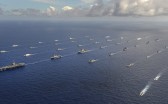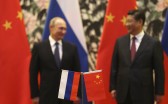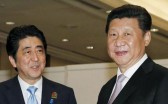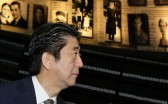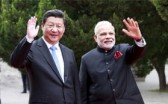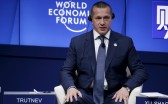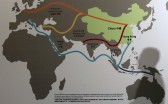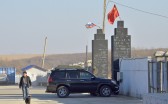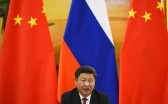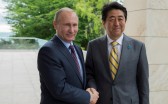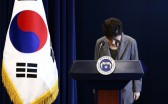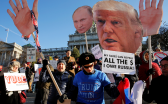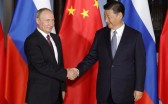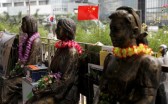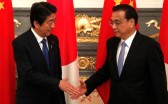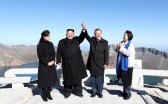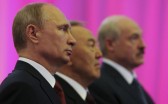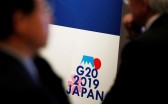Two months following the passage by the ROK National Assembly of a motion of impeachment against Park Geun-hye, power remains in the hands of Acting President Hwang Kyo-ahn, South Korean conservatives are split between the pro-Park New Liberty Korea Party and the newly-established anti-Park Bareun (Righteous) Party, and a series of investigations has expanded the dimensions of South Korea’s political scandal and threatened to ensnare top Korean corporate leaders.1 South Korea’s most experienced leader in international affairs, former UN Secretary General Ban Ki-moon, ended his flirtation with presidential politics by concluding that he should remain out of the race, seemingly turning a looming presidential election into a fight among progressives.2 Hwang has succeeded, thus far, in fulfilling his caretaker role, insofar as he has kept current policies in place and maintained government momentum despite the looming threat of politicization and reversal of Park Geun-hye’s major foreign policy decisions. But while South Korea stands still and awaits new political leadership, regional tensions are increasing and potential cleavages in the Northeast Asian security environment are becoming more apparent.
True, the crisis has been a test of the impressive responsiveness of South Korean democratic institutions to public demands for transparent and clean government, but this display comes against the backdrop of a global turn toward nationalism and backlash against globalization. Both of these trends pose serious risks for a vulnerable and trade-dependent South Korea’s economic well-being and national security. South Korea runs the risk of repeating the historical precedent of allowing factionalism in domestic politics to paralyze an effective political response to rising external geopolitical risks and dangers. South Korea’s transitional government, its ongoing political vacuum, and its looming domestic power transition are affecting South Korean geopolitical risks in the following ways.
Efforts to Influence the Transition to a Trump Administration
North Korea’s resumption of missile tests on February 12, 2017, with a test of a solid-fueled land-based ballistic missile following a four-month hiatus, has renewed pressure on the Trump administration to prioritize a counterstrategy to defeat North Korea’s development capabilities to threaten the United States and its allies.3 Following tweets in early January asserting that North Korea achieving the ability to hit most parts of the United States “won’t happen” and holding China responsible for reigning in North Korea, the Trump administration has ordered a North Korea policy review, sent Defense Secretary James Mattis on a reassurance tour to South Korea and Japan in late January, and had Trump himself pledge to “stand behind” Japanese allies in a joint press conference with Prime Minister Abe Shinzo held in response to North Korea’s missile launch.4 Otherwise, the Trump administration has held its rhetorical fire, presumably pending the administration’s review of policy toward North Korea and development of a coherent strategy for responding to the North.
The fact that North Korea’s first missile test under the Trump administration occurred while Trump and Abe were having dinner together in Florida, provided an opportunity for Trump to emphasize the importance of a coordinated response among allies. However, his failure to acknowledge that the missile test was an important alliance coordination issue between the United States and South Korea can be attributed, to some degree, to South Korea’s political vacuum. In contrast to Abe’s flurry of diplomatic activity, including four visits to the United States within the past half year, South Korea’s political leadership has remained in the penalty box pending the final judgment of the Constitutional Court over whether to uphold the validity of the National Assembly’s impeachment of Park.5
Even the visit of National Security Advisor Kim Kwan-jin, to the United States has been a subject of debate within South Korean politics. Since his office is physically located at the Blue House complex, some viewed his visit for early talks with the Trump administration during the transition period to be a violation of the National Assembly’s impeachment motion, with a Minjoo party member noting that his act was “definitely an act exceeding an authority.”6 Given that the Trump administration was still in its transition phase, it was inevitable that the only people in place to represent it were at the National Security Council. Sending Kim, who represents the South Korean counterpart of the US National Security Council, was a bow to the reality of the Trump transition and an effort to maintain coordination between governments as closely as possible despite the vacuum in Seoul and the transition in Washington.
Political Relations With Near Neighbors
A second cost of South Korea’s political vacuum has come in the form of a broken relationship between South Korea and Japan. This development has occurred because South Korea’s political vacuum made it possible for South Korean NGOs to challenge the December 2015 “comfort woman” agreement by placing a statue outside the Japanese consulate in Busan (in addition to the one outside the embassy in Seoul that Park had pledged to try to remove in that deal) at a time when there is no politically empowered central government leader able to assert national prerogatives as a priority over local sentiments. Instead, the local authorities initially removed the statue, but then relented and replaced it in response to public sentiment.7 In response, the government of Japan recalled its ambassador to Tokyo.8 Meanwhile, Japanese government ministers including the minister of defense paid their respects personally at the Yasukuni Shrine.9
A major unspoken premise underlying the “comfort woman” agreement has been challenged by these developments: that both South Korea and Japan would need to bring domestic political forces under control in order to preserve a normal relationship between the two governments—a task that is easier said than done in a democratic political system. There is no prospect that the issue can be successfully resolved in the midst of an impending presidential campaign, i.e., it will be difficult to resolve the current tensions until South Korea chooses its president, who will have to figure out how to repair the relationship with Japan as one of his early presidential tasks.
At the same time, China’s challenge to South Korea’s domestic politics continues to grow through its economic retaliation to South Korea’s agreement to deploy THAAD on South Korean territory. China has quietly imposed non-tariff barriers on pop culture and cosmetics from South Korea, subjected businesses affiliated with the Lotte Group to intense audits in retaliation against Lotte’s decision to sell a golf course to the ROK government in connection with the THAAD deployment, and reduced the flow of Chinese tourists to South Korea.10 In addition, China has privately sent envoys to warn South Korea of the consequences of its decision while publicly hosting opposition national assemblymen who saw opportunities for a photo op with China’s foreign minister.11 However, despite continued criticism of the Park administration for a lack of transparency in the announcement of the THAAD deployment, Chinese political pressure seems more likely to push South Korea’s political leaders toward acceptance of the deployment.
Impact on South Korea’s Economic Growth
Park’s scandal removed the momentum for the South Korean government to secure a raft of reforms to structures that are widely perceived as obstacles to South Korean economic growth. For instance, high-levels of youth unemployment and high rates of temporary labor are directly connected to a rigid labor market, which protects permanent workers regardless of their productivity or contributions.12 The momentum for these sorts of structural reforms has completely dissipated as the National Assembly focuses solely on investigations of scandals and short-term political maneuvering in anticipation of the next presidential election. Park’s “creative economy” initiatives, which emphasized establishment of innovation hubs and promoted creation of new start-ups as a means to generate new jobs and strengthen South Korean competitiveness, are surely thwarted by the overall political malaise that has struck South Korea.13
Moreover, the main remaining sources of growth in exports, exceptionally important for growth in the South Korean economy, are tied to international competitiveness and are dominated by the chaebol. But the heads of the largest chaebol have been entrapped in Park’s scandal. Almost every large conglomerate has been entrapped by Choi Soon-sil’s rent-seeking, either through direct extortion related to fundraising for her sports foundations or as part of efforts to shake down companies by locking in exclusive PR contracts. Samsung CEO Lee Jae-yong has been detained. Samsung and other major chaebol have pulled out of the Federation of Korean Industries and political arousal over income inequality is likely to produce a president with a mandate to challenge chaebol privilege within South Korean society in one form or another, raising uncertainty about economic policies under the next administration.14
Response to North Korean Crisis
Hwang Kyo-ahn has spent a good deal of time organizing responses to North Korean developments, including the resumption of missile testing and the assassination of Kim Jong-nam. Fortunately, there has not yet been a North Korean provocation that would require a real political decision from the caretaker leader. Given that South Korea’s political vacuum provides a windfall to the North, Pyongyang has shown reluctance to do much that would distract from South Korea’s political malaise. However, a North Korean provocation against the South would also provide the gravest and most difficult challenge to an acting South Korean leadership with no political mandate to respond. Perhaps, the wide degree of uncertainty regarding possible South Korean responses is actually the surest deterrent against North Korea’s usual propensity for risk-taking, given the evident vulnerabilities and paranoia surrounding Kim Jong-un’s own efforts to consolidate his power. Although North Korean intervention at a time of South Korean vulnerability might be tempting, Pyongyang’s efforts to influence South Korean politics have repeatedly proven to be counterproductive. It would be better for Pyongyang to assess the situation after it sorts itself out and then determines a course of action.
Conclusion
The costs and consequences of South Korea’s political vacuum have mounted as the crisis has ballooned and South Korea has continued on autopilot without a clear sense of political direction. Only a new mandate from the South Korean people and the energy of a new administration empowered to implement the political will of the people will enable South Korea to overcome its current problems. The longer the situation is prolonged, the greater the costs of inaction, and the harder it will be for a new leadership to regain lost momentum resulting from South Korea’s current political drift.
1. “Opposition Parties Take Issue with Ruling Party’s New Name,” Yonhap News Agency, February 14, 2017, http://english.yonhapnews.co.kr/news/2017/02/14/0200000000AEN20170214007451315.html.
2. Anna Fifeld, “Blaming ‘Fake News,’ Ban Ki-moon Drops Presidential Bid in South Korea,” The Washington Post, February 1, 2017, https://www.washingtonpost.com/world/former-un-chief-ban-ki-moon-will-not-run-for-president-of-south-korea/2017/02/01/b05c816d-9ce5-4c3a-84be-0e5b78890a17_story.html?utm_term=.7768750438c5#comments.
3. Elizabeth Shim, “North Korea launch was upgraded sub-launched missile,” UPI, February 13, 2017, http://www.upi.com/Top_News/World-News/2017/02/13/North-Korea-launch-was-upgraded-sub-launched-missile/6091486996285/.
4. Sarah Kim, “White House Talks Tough About the Test Launch,” JoongAng Daily, February 14, 2017, http://koreajoongangdaily.joins.com/news/article/article.aspx?aid=3029818.
5. Hiroshi Minegishi, “South Korea Fears Isolation as Japan Bonds with US,” Nikkei Asian Review, February 16, 2017, http://asia.nikkei.com/Politics-Economy/International-Relations/South-Korea-fears-isolation-as-Japan-bonds-with-US.
6. Quoted in Sarah Kim, “Flynn Describes US-Korea Relationship as ‘Sticky Rice Cake,’” JoongAng Daily, January 12, 2017, http://koreajoongangdaily.joins.com/news/article/article.aspx?aid=3028516.
7. Sang-hun Choe, “‘Comfort Woman’ Statue Reinstated Near Japan Consulate in South Korea,” The New York Times, December 30, 2016, https://www.nytimes.com/2016/12/30/world/asia/south-korea-comfort-women-wwii-japan.html.
8. “Japan Envoys Leave S. Korea in Protest Over ‘Comfort Woman’ Statue,” Yonhap News Agency, January 9, 2017, http://english.yonhapnews.co.kr/news/2017/01/09/0200000000AEN20170109003751315.html.
9. Young-A Soh, “Japan’s Defense Minister Visits War-linked Shrine After Pearl Harbor Trip,” Dong-A Ilbo, December 30, 2016, http://english.donga.com/List/3/all/26/814649/1.
10. Jae-hyuk Park, “China Intensifies Economic Retaliation Against Korea,” Korea Times, December 2, 2016, http://www.koreatimes.co.kr/www/news/biz/2016/12/123_219418.html.
11. Jingxi Mo, “Beijing Urges ROK Delegation to Halt THAAD,” China Daily, January 6, 2017, http://www.chinadaily.com.cn/china/2017-01/06/content_27877529.htm.
12. Stephan Haggard, “The Demonstrations in Seoul: The Labor Backstory,” North Korea: Witness to Transformation, November 16, 2015, https://piie.com/blogs/north-korea-witness-transformation/demonstrations-seoul-labor-backstory.
13. Chong-un Cho, “Korea on Tough Road to Transformation,” Korea Herald, December 30, 2015, http://www.koreaherald.com/view.php?ud=20151230001174.
14. Sang-hun Choe and Motoko Rich, “As Scandal Roils South Korea, Fingers Point to Mixing of Politics and Business,” The New York Times, January 2, 2017, https://www.nytimes.com/2017/01/02/world/asia/south-korea-park-geun-hye-samsung.html.
